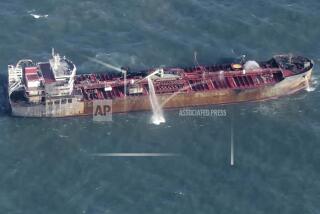Crews Put Out One Major Fire on Gulf Tanker
- Share via
GALVESTON, Tex. — Firefighters boarded the supertanker Mega Borg on Tuesday and put out the fire in the vessel’s pump room, a major step toward extinguishing the 3-day-old blaze.
For the first time since an explosion transformed the vessel into an inferno, the tide turned in favor of the hundreds of workers trying to keep the oil-laden vessel from sinking into the Gulf of Mexico about 50 miles off the Texas coast.
Ted Hoskins, who heads the salvage operation, boarded the ship late in the day and told the Coast Guard that he would characterize the fire as “under control.” But the hope of quickly dousing the remaining flames below decks ended as darkness began to fall.
“They are getting closer to a point where they may be able to put foam on the fire,” said Coast Guard Capt. Thomas Greene at a mid-day news conference. “At this point, I’m encouraged by the progress we’ve made. But there is still a chance for a major problem, a major release (of oil).
“We’re still not completely safe from a major release until the fire is out and the ship is stabilized and it is brought on an even keel.”
The Coast Guard revised its estimate of the amount of oil remaining on the water to less than 2,000 gallons, down from the 100,000 gallons estimated earlier. The total amount spilled from the tanker, which was carrying 38 million gallons, has not been determined.
Greene said that the tanker did not seem in danger of sinking and that he hoped the foaming operation would begin in the afternoon.
But as the hours dragged on in the afternoon, Smit American, the salvage company in charge of the firefighting, continued to hold back on laying down the foam. The company said that, if the metal was too hot, there could be recurring explosions that could undo all the progress made thus far.
An expert in marine and refinery firefighting criticized Smit American’s handling of the fire Tuesday, saying the company could have used equipment in Texas rather than sending to Europe for it. The transport of the equipment delayed the beginning of the actual firefighting by two days, by which time the ship had begun to list, waves were washing on the stern deck and thousands of barrels of oil were spewing from the stern.
“We have $600,000 worth of firefighting equipment in a Port Neches warehouse,” said Les Williams, one of the owners of Williams, Boots & Coots, which is based in Port Neches, Tex. “If they (the tanker owner) would have called us on Saturday morning, Monday morning would have been Miller time.”
Williams took issue also with Smit American’s contention that high temperatures delay foaming.
Smit American could not be reached for comment. The company is a well-known salvage and tow operator that in recent years also has been fighting marine fires. Greene of the Coast Guard endorsed the company. “If this were my spill, I would go out and hire the people doing it right now,” he said.
The spill began on Saturday morning, when the supertanker was transferring its cargo onto another tanker for transport to the port of Houston. Just after 1 a.m., an explosion rocked the pump house, through which the transferred oil must pass, and blew off the roof of the room in the stern of the ship. Two men were killed and two others are missing and presumed dead.
The fire in the stern spread to the engine room and the living quarters, and, about 24 hours after the first explosion, there were five more blasts in the interior. The damage from those explosions allowed light crude to escape from at least one of the 16 compartments on board, sending it rolling afire over the stern deck and into the water.
On Monday, the amount of oil spilling into the water steadily increased through the day as the tanker began to list. By late afternoon, waves were crashing over the stern deck.
Tuesday brought more promise. Smoke surrounded the superstructure of the 886-foot vessel, but the flames on the water were out, as was the fire in the pump room.
Meanwhile, a fleet of oil skimmers worked around the crippled tanker, trying to keep the crude spill from widening. Jim O’Brien, who is serving as a technical adviser for the cleanup, said the oil was, for the most part, a very thin sheen on the water that should dissipate before it came anywhere close to shore.
“My personal opinion is that the opportunity to reach the shoreline doesn’t exist,” he said. “I do not see how it could possibly strand itself on the beaches of Texas.”
He, as well as the Coast Guard, was unable to predict just how much of the Mega Borg’s cargo had been released from the tanker. O’Brien said no more than 400 barrels of oil had been recovered. Much of the oil was eliminated because it was consumed by fire.
The Mega Borg is carrying more than three times amount of oil spilled by the Exxon Valdez off the coast of Alaska in 1989. That spill was the nation’s worst.
Times researcher Lianne Hart contributed to this story.
More to Read
Sign up for Essential California
The most important California stories and recommendations in your inbox every morning.
You may occasionally receive promotional content from the Los Angeles Times.









